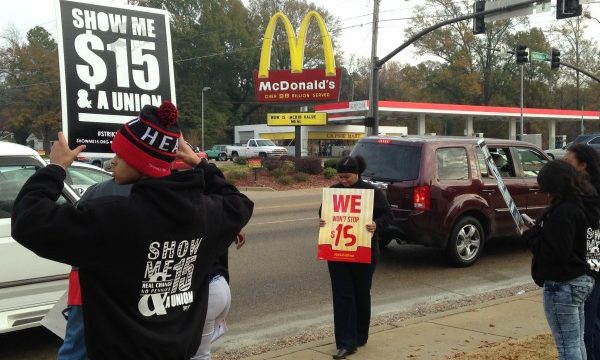Loss of entry-level jobs a tragedy for American workforce

We WANT $15: Protesters advocating for higher wages for fast food workers hold up signs during a rally at a street corner in Jackson, Mississippi.
By Steve Wilson | Mississippi Watchdog
A whole generation isn’t learning the value of a dollar.
Entry-level jobs represent opportunities for young workers to learn basic skills as they climb the employment ladder, and it’s an opportunity that fewer are getting.
Data from the Bureau of Labor Statistics show the youth employment rate — workers ages 16-24 — is in a state of serious decline. In the mid to late 1980s, the percentage of employed youths ranged from 81 percent to 86 percent. In July, the month considered the peak for youth employment, only 51.9 percent had a job.
DECLINING: The number of hourly workers making minimum wage, with the exception of a few upticks, has been on a downward trend since 1979.
When the minimum wage was $2.90 per hour in 1979, minimum wage workers represented 13.4 of all hourly wage earner, according to the BLS. That $2.90 in 1979 equals $9.48 in today’s dollars, according to the BLS.
Even though the minimum wage of $7.25 has less buying power, the number of minimum-wage workers as a share of the workforce has declined from 4.7 percent in 2012 to 4.3 percent in 2013. While there have been some upticks in the percentage between 1979 to 2013, the trend generally has been downward.
Yet the Obama administration and Democrats in the U.S. Congress want to raise the minimum wage to $10.10 per hour, and this wouldn’t be without consequences. A study by David Neumark, a professor of economics at the University of California-Irvine, and William Wascher, an Senior associate director in the Division of Research and Statistics at the Federal Reserve Board, shows increasing the minimum wage reduces employment for the least skilled while having no effect on poverty rates.
Imagine if protesters in Jackson, Mississippi, and across the country who demonstrated Thursday outside of fast-food restaurants for a $15 per-hour wage and union representation got what they want. The job losses would be unimaginable.
When the government arbitrarily increases the cost of labor, companies cut costs to maintain profits. When wages are increased capriciously, employers can’t afford to take a chance on untested, younger workers without experience. Despite the constant demonization of profits by those on the left, that’s the sole reason for a business. Unlike a government jobs program, a publicly traded company is accountable to its shareholders, and those shareholders invest to make a profit.
A lack of those skill-building opportunities from entry-level jobs could prove costly to youngsters in the long run.
Entry-level jobs are the means by which young workers learn how to show up on time, how to respond to being managed and how to regulate their time. Those are skills that aren’t taught in any high school or college.
A study by Christopher Ruhm, a professor of public policy and economics and associate dean for Academic Affairs at the University of Virginia, and Charles Baum, a professor of economics at Middle Tennessee State University, found that workers who were employed as seniors in high school in the late 1970s and early 1980s earned 11 percent more in their later years than those who didn’t work as teenagers.
Teenagers who don’t have a steady income miss out on a vital introduction to financial management and solid decision-making that will pay dividends, no pun intended, later in life.
More, not fewer, teenagers are needed in the workforce. Entry-level jobs represent a teaching and character-building opportunity that can’t be found in high schools and colleges.
It’s a national tragedy that isn’t getting the attention it deserves.
Get regular updates on Mississippi through our Facebook or Twitter accounts







